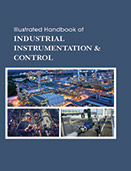Engineering and Technology

Instrumentation and control are interdisciplinary fields. They require knowledge of chemistry, mechanics, electricity and magnetism, electronics, microcontrollers and microprocessors, software languages, process control, and even more such as the principles of pneumatics and hydraulics and communications.
Illustrated Handbook of Industrial Instrumentation & Control discusses the basic concepts and principles that govern the operation of industrial plants. Concepts associated with measurements of flow, level, temperature and pressure, electronics and pneumatics instrumentation, control loops, PID control, and others will be addressed.
Industrial measurement and control systems have their own unique terms and standards, which is the primary focus of this book. Instrument technicians maintain the safe and efficient operation of industrial measurement and control systems. As this book shows, this requires a broad command of technical skill. Instrumentation is more than just physics or chemistry or mathematics or electronics or mechanics or control theory alone. An instrument technician must understand all these subject areas to some degree, and more importantly how these knowledge areas relate to each other.
The all-inclusiveness of this profession makes it very challenging and interesting. Adding to the challenge is the continual introduction of new technologies. The advent of new technologies, however, does not necessarily relegate legacy technologies to the scrap heap. It is quite common to find state of- the-art instruments in the very same facility as decades-old instruments; digital fieldbus networks running alongside 3 to 15 PSI pneumatic signal tubes; microprocessor-based sensors mounted right next to old mercury tilt-switches. Thus, the competent instrument technician must be comfortable working with both old and new technologies, understanding the relative merits and weaknesses of each.
This Illustrated Handbook of Industrial Instrumentation & Control provides a comprehensive introduction for engineering students shaped by a variety of applications including control, quality assurance, performance testing, design and research. It aims to provide a fundamental background in the theory of Industrial Instrumentation and measurement system performance and; to establish the physical principles and practical techniques used to measure those quantities most important for Instrumentation applications.